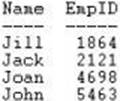SAS Institute A00-211 SAS Base Programming for SAS 9 Online Training
SAS Institute A00-211 Online Training
The questions for A00-211 were last updated at Dec 11,2025.
- Exam Code: A00-211
- Exam Name: SAS Base Programming for SAS 9
- Certification Provider: SAS Institute
- Latest update: Dec 11,2025
Given the raw data record in the file phone.txt:

Which SAS statement completes the program and results in a value of "James Stevens" for the variableFullName?
- A . FullName=CATX(”,EmpFName,EmpLName);
- B . FullName=CAT(”,EmpFName,EmpLName);
- C . FullName=EmpFName!!EmpLName;
- D . FullName=EmpFName + EmpLName;
Given the SAS data set EMPLOYEES:
EMPLOYEES
NAME SALARY
——– ————
Innis60000
Jolli50000
Ellis55000
Liu45000
The following SAS program is submitted:
proc print data = employees; where name like ‘_i%’;
run;
What is contained in the output?
- A . Liu only
- B . Innis and Ellis only
- C . Innis, Ellis, and Liu only
- D . Innis, Jolli, Ellis, and Liu
The following SAS program is submitted:
data one;
addressl = ‘214 London Way’;
run;
data one;
set one;
address = tranwrd(address1, ‘Way’, ‘Drive’); run;
What are the length and value of the variable ADDRESS?
- A . Length is 14; value is ‘214 London Dri’.
- B . Length is 14; value is ‘214 London Way’.
- C . Length is 16; value is ‘214 London Drive’.
- D . Length is 200; value is ‘214 London Drive’.
The following program is submitted:
proc contents data=_all_;
run;
Which statement best describes the output from the submitted program?
- A . The output contains only a list of the SAS data sets that are contained in the WORK library.
- B . The output displays only the contents of the SAS data sets that are contained in the WORK library.
- C . The output displays only the variables in the SAS data sets that are contained in the WORK library.
- D . The output contains a list of the SAS data sets that are contained in the WORK library and displays the contents of those data sets.
Which program displays a listing of all data sets in the SASUSER library?
- A . proc contents lib = sasuser.all; run;
- B . proc contents data = sasuser.all; run;
- C . proc contents lib = sasuser._alI_; run;
- D . proc contents data = sasuser._all_; run;
Given the SAS data set WORK.EMP_NAME:

Given the SAS data set WORK.EMP_DEPT:

The following program is submitted:

How many observations are in data set WORK.ALL after submitting the program?
- A . 1
- B . 2
- C . 3
- D . 5
The following SAS program is submitted:
data test;
infile ‘file specification’;
input name $ amount@@;
run;
Which of the following is true?
- A . Two @@ together are the same as one c.
- B . Two @@ hold the data records until the bottom of the DATA step.
- C . Two @@ hold the raw data record across iterations of the DATA step.
- D . Two @@ are invalid syntax and will cause the program to fail to execute.
Which statement correctly computes the average of four numerical values?
- A . average = mean(num1, num4);
- B . average = mean(num1 – num4);
- C . average = mean(ofnum1 – num4)
- D . average = mean(num1 num2 num3 num4);
The following SAS program is submitted:

What new variables are created?
- A . Difcount1, Difcount2 and Difcount3
- B . Diff1, Diff2 and Diff3
- C . Janpt, Febpt, and Marpt
- D . Patients1, Patients2 and Patients3
Given the SAS data set ONE:
ONE
ObsDte
————-
109JAN2005
212JAN2005
The following SAS program is submitted:
data two;
set one;
day = <insert expression here>;
format dte date9.;
run;
The data set TWO is created:
TWO
ObsDteDay
109JAN20051
12JAN20054
Which expression successfully completed the program and created the variable DAY?
- A . day(dte)
- B . weekday(dte)
- C . dayofweek(dte)
- D . datdif(dte,’01jan2005’d,’act/act’)
Latest A00-211 Dumps Valid Version with 270 Q&As
Latest And Valid Q&A | Instant Download | Once Fail, Full Refund

